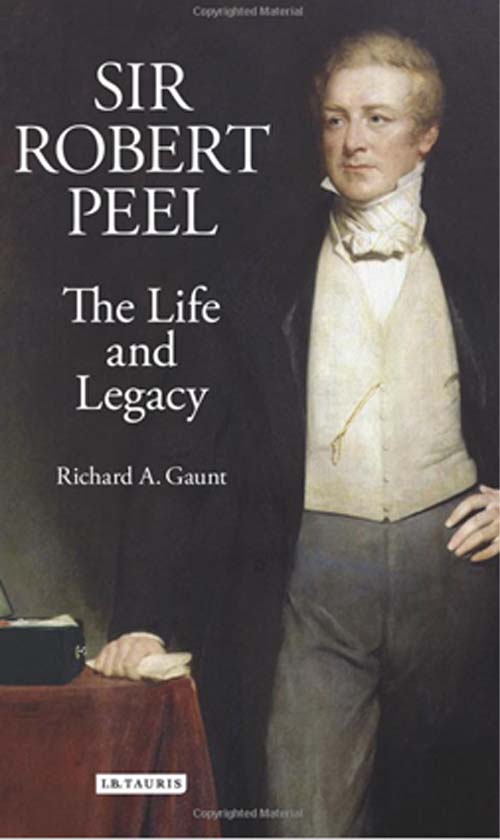Sir Robert Peel: The Life and Legacy
Review

Sir Robert Peel: The Life and Legacy by Richard A. Gaunt
(I.B. Tauris), 2010
264pp., £20 hard. ISBN 978-184885354
The two-volume biography of Peel by Norman Gash was published in 1961 and 1967. Gash sees Peel as a pragmatic administrator and an instinctively consensual politician whose great achievement was to establish the principles of the modern Conservatism. For Gash, the Tamworth Manifesto was the key document in the evolution of Conservative ideas with its emphasis that his party must accept the need for gradual change to become a viable party of government and occupy the middle ground in politics. He argues that Peel helped the Conservatives extend the social basis of their support by appealing to urban middle-class voters as well as landowners and farmers. Even the Conservatives who repudiated his leadership in 1846, soon learned that there was no alternative but to adopt Peelite approaches to politics. Gash concluded that the period between 1830 and 1850 in British history was justifiable known as the ‘Age of Peel'.
This assessment of Peel has been called into question by a number of historians approaching the subject from different positions. Peel's allegedly pragmatic style of administration, for example, does not fit well with his resolutely anti-reformist stance that he took on many major issues early in his career. For example, Gash presented his efforts of consolidate the criminal law, abolishing many capital offences in the process as evidence of Peel's humanitarian concerns. In 1974, however, Derek Beales demonstrated that Peel's rationalisation of statutes had only limited effects and that credit was really due to the Whig ministers who continued the reforms in the 1830s. Gash may be right in arguing that Peel tried to persuade the Conservative party to be more adaptable but Robert Stewart and Ian Newbould have both shown that, despite Peel's advocacy, the Conservative party was little changed by 1841. The most important revision of Gash's view of Peel has come from Boyd Hilton in a seminal article published in 1979. He does not regard Peel as a pragmatist who sought the middle ground in politics, but as a rigid and doctrinaire leader who was unwilling to compromise on his views. He maintains that Peel's intellect was readily susceptible to the charms of a system and once convinced of the theoretical correctness of a proposition, it was necessary for him to fit everything else into the model: a restatement of Walter Bagehot's contemporary view of Peel as a first-class statesman with a second-class brain. The problem was that Peel had an insufficiently flexible or creative intellect to adjust the model when the ‘facts' did not fit. So Boyd Hilton concludes that Peel's legacy was not to modern Conservatism but that he could properly be seen as the originator of Gladstonian Liberalism and certainly the ‘moral energy' created by his supreme sacrifice in 1846 was eventually transfused into the Liberal political tradition. Peel's stature as a Great Statesman may have been reduced to some degree by recent historical writing. In part, this historiographical reaction against Peel is a consequence of the attention currently being given to the Whig governments of the 1830s and 1840s. We can no longer treat them as dismissively as Gash did. Yet, as Douglas Hurd's biography published in 2007 shows, Gash continues to cast a long shadow.
Richard A. Gaunt's study of Peel is particularly welcome as it synthesises the revisionist work that has led to changes in the ways in which Peel is regarded by historians. It is important that we get beyond Peel as the founder of modern Conservatism and as an individual who put country ahead of party in 1829 and especially 1846. As Donald Read found in his study of Peel and the Victorians and extended in this book, Peel's legacy is far from clear despite the genuine outpouring of grief at his premature death in 1850. The critical question is whether he was a Conservative at all but rather a doctrinaire supporter of free trade liberalism that was taken to its zenith in the governments and policies of William Gladstone. One thing that is certain about Peel is that he was a supremely self-confident performer in the House of Commons, whose speeches are among the most eloquent in the nineteenth century and whose mastery of the detail of administration was sans pareil. In eight closely argued and succinct chapters, Richard Gaunt has produced what may well be the best study of Peel since Gash's seminal studies. He surveys Peel in his historical perspective as the opening chapter and this makes clear that he intends to critique the existing historiography. This is followed by thematic chapters that consider the main areas where Peel made him mark: Ireland; currency reform; as Home Secretary in the 1820s where his reforms, according to Gaunt mark him out of an ‘illiberal' Liberal Tory; as founder of modern Conservatism; and the question of tree trade reform and repeal of the Corn Law. The book ends with two chapters on Peel after 1846 and death and posterity. The notes and bibliography are extensive making up almost a quarter of the book and they are exceptionally valuable as a result. There is also a good index.
What makes this a very good book is the ease with which the author has combined good writing and sound scholarship. It is an excellent and stimulating read as well as being an important study of Peel and his ambiguous achievements. Richard Gaunt has unpicked contemporary and historical attitudes to Peel to produce a book that will be of real value for teachers and student.

